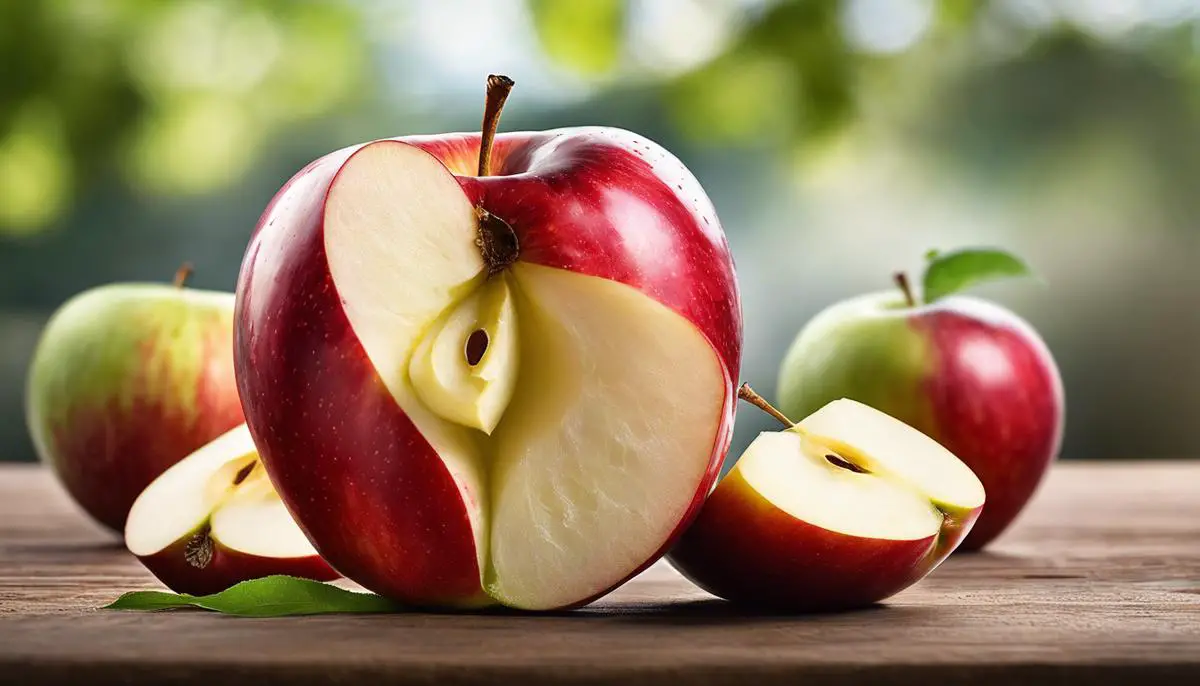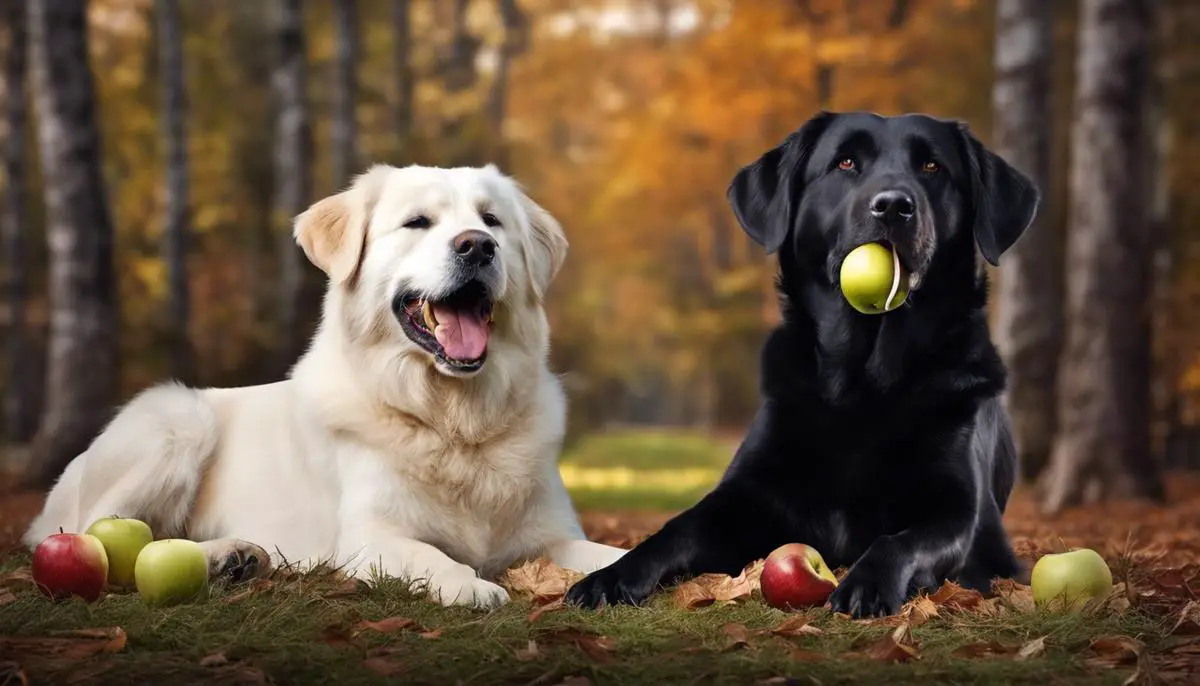When it comes to treating our lovable pets, the first thing we think about is their happiness. But, another aspect equally or more important is their health. Numerous fruits and vegetables can be healthy treats for our canine companions, but knowing the benefits and risks associated with each is crucial. A common fruit, the apple, is often a topic of debate among pet owners. Some love feeding this healthy snack to their dogs, while others worry about potential drawbacks. This article intends to clear all your doubts about letting dogs eat apples. We’ll be exploring the nutritional values of apples for dogs, the potential risks when dogs consume apples and finally, guide you on the correct way to feed apples to your dogs.
The Nutritional Value of Apples for Dogs
Title: Explore the Nutritional Wonders of Apples for Our Furry Friends
Every now and then, we parents find ourselves playing dual roles, nurturing not just our human kids but also our beloved four-legged family members. As enthusiastic pet parents, we understand how keeping our furry pals in top-notch health is always a priority. So let’s dive into a popular and potentially beneficial food for our pet dogs, a fruit as common as an apple.
Now, one might ponder, are these crunchy treats really good for our dogs? Well, let’s unwrap the goodness that hides within the thin skin of an apple.
Apples, particularly their flesh, are chock-full of beneficial nutrients. They are a rich source of dietary fiber, which aids in maintaining a healthy digestive system in dogs. The fiber acts as a natural regulator of the digestive system, helping everything run smoothly and avoiding bouts of constipation or diarrhea. It also assists in weight management in dogs, promoting satiety and thus reducing the tendency for overeating.
Next up is Vitamin A. This vitamin is crucial for maintaining a dog’s healthy immune system and promotes better vision. Not to forget, it plays a significant role in skin and coat health, so your canine friend stays not just healthier but also shinier on the outside.
Another great nutrient offered by apples is Vitamin C. This powerhouse nutrient helps to combat free radicals thereby helping to slow down aging and disease progression. A lesser-known fact is that healthy dogs can produce Vitamin C on their own. However, during stressful times or sickness, supplementing with additional Vitamin C through diet can certainly give their health a boost.
Apples are also an excellent source of antioxidants. These help in reducing the risk of chronic diseases and inflammation in dogs. They might also support brain health, potentially delaying age-related cognitive decline.
It’s impressive knowing the myriad of nutrients our humble apple contains. Yet, as is often the case, moderation is key. Apples should be served in reasonable portions and always with caution. Since apples’ seeds contain cyanide, they should be removed before feeding this fruit to dogs. Too much apple can also lead to stomach upset because of the fruit’s higher fiber content. So, while apples can be pulpy paradise for dogs, they should be given in moderation and definitely not act as a substitute for a balanced diet.
Isn’t it delightful to know that sometimes the simple act of sharing your lunchtime apple with your dog can work wonders for their health? What a perfect example of love in shared bites! So, the next time you find your furry friend eagerly eyeing your apple, remember this is one treat you can indulge them in, all while fostering better health.
With all these in mind, we continue to establish the notion of responsible pet parenting, where a little knowledge can contribute hugely towards creating a healthier life journey for our furry friends. Here’s to more tail-wags and happier times all around the comfort of our homes and the happiness that sound pet-health brings!

Potential Risks of Dogs Eating Apples
Mitigating Risks Associated With Dogs Eating Apples
We all want to provide the ultimate health benefits to our furry companions, but sometimes, we unintentionally expose them to certain risks, even with something as wholesome as apples. While we’ve addressed the myriad health benefits of apples for dogs, it’s equally important as responsible pet parents to raise the curtain on potential dangers they can pose and how to curb them.
Primarily, a notable hazard that apples can pose to dogs relates to their cores, notably the apple seeds and stems. While it’s widely circulated that apple seeds can be harmful to dogs, let’s delve deeper into understanding why. Apple seeds contain a natural chemical that releases cyanide when digested – a substance that can lead to cyanide toxicity in dogs. Reassuringly, a dog must ingest several apple cores to reach a lethal dose; however, even small amounts can cause digestive upset.
Another risk emerges from dogs gnawing on apple cores, which can become choking hazards. Apple cores are hard and large, often not chewed entirely, leading to potential choking and blockages in the gastrointestinal tract.
Furthermore, our furry friends don’t have the same robust digestive systems as we do. Their stomachs may struggle with large quantities of high-fiber food, like apples. Regularly feeding your dog large quantities of apples may lead to gastrointestinal complications, including diarrhea and constipation.
So, how can you ensure your beloved companion reaps the benefits of apples without facing these hazards? With a few simple practices, we can make apple-snacking enjoyable and safe for our pups.
Firstly, always remove the core and seeds before offering your dog an apple. Choking hazards and toxic seeds are quickly eliminated once the core is disposed of. Besides, spoiling your canine with apple slices will ensure they are not tempted to swallow large, chunky pieces whole.
Secondly, remember that size matters. Discerning portion size based on your dog’s breed, size, and dietary needs is crucial. Smaller breeds might do well with half a slice, while larger dogs can handle a whole apple (seedless, of course). Apples should be supplementary treats rather than meal replacements— around 10% of your dog’s daily calories can be sourced from treats or snacks.
Lastly, introduce apples slowly into your dog’s diet to monitor possible upsets or intolerances. Apples are usually well-accepted, but every dog is individual. Start small and gradually increase the portion if everything seems fine.
When equipped with the right knowledge, canine parents can unlock the nutritional powerhouse that apples can be, minus the encumbering dangers. After all, our ultimate goal is to dish out the love in the healthiest servings possible, one apple slice at a time.

The Correct Way to Feed Apples to Dogs
The Safest Ways to Feed Your Dog Apples
The moment we decide to bring a dog into our home, most of us make an unspoken commitment to do everything in our power to provide a healthy, happy life for our furry friends. Part of that commitment involves knowing what our dogs can safely eat. Though it’s clear apples are a nutritious treat for our canine companions, there are crucial factors to consider when serving apples to dogs.
A crucial step to remember is that apple seeds and cores should not be fed to dogs. Apple cores pose a risk of choking, and apple seeds contain a small amount of cyanide. While small amounts are harmless, excessive consumption can lead to cyanide toxicity in dogs. When preparing apples for dogs, remove the core and seeds, ensuring every slice is seed-free. Also, it is best to cut apple pieces into bite-sized chunks appropriate for your dog’s size to prevent choking.
Another thing to remember is to introduce apples or any new food to your dog’s diet gradually. The digestive system of dogs can be sensitive to new foods, especially fruits and vegetables high in fiber such as apples. Start by feeding small amounts then increase gradually if no adverse reactions appear.
Portion control plays a vital role as effectively. Remember the “10% rule”-treats should make up no more than 10% of your dog’s daily caloric intake. Keep in mind, while apples are low-cal and packed with nutrients, the sugar content may contribute to unwanted weight gain if fed in large amounts.
Always observe your dog while they are eating their apple treat – familiarize yourself with the signs of choking, and intervene promptly if you suspect your furry friend is struggling. This diligent supervision is especially important for dogs who tend to “gobble” their food without thorough chewing.
In summary, apples can be a delightful treat for dogs, contributing to their dietary variety and delivering beneficial nutrients. However, like introducing any new food, it’s crucial we approach this with careful guidance. By skipping the core and seeds, limiting portion sizes, and gradually including apples into a dog’s diet, pet parents can best ensure a safe, enjoyable apple-eating experience for their dogs.
As dog lovers and responsible pet parents, it is our primary duty to provide them with a healthy life, fueled by nutritionally balanced meals and safe, nutritional snacks. An apple a day, served safely, could indeed help keep the vet away! Last but not least, consult with your veterinarian before introducing any new foods to your pet’s diet. Every dog is unique, and their dietary needs may vary.
Be dedicated to their well-being like you are in all facets of homemaking. And never forget that they too are a part of the family and equally deserve attention and care in all aspects – including their nutrition!

Understanding the nutritional value of apples for dogs, the potential risks of consumption and the proper way to serve this fruit is crucial to maintain the health of your pet. Not all human foods are safe for dogs, but when served properly, apples can be a tasty and healthy treat indeed. However, it’s always a good rule of thumb to introduce any new food into your dog’s diet gradually, and monitor them closely for any adverse reactions. Remember, the key to a balanced dog diet is variety along with plenty of proteins and carbohydrates. Despite all the preparation steps, most dogs enjoy their crunchy, sweet apple treat, and it’s an excellent way to reward them while keeping them healthy and happy.